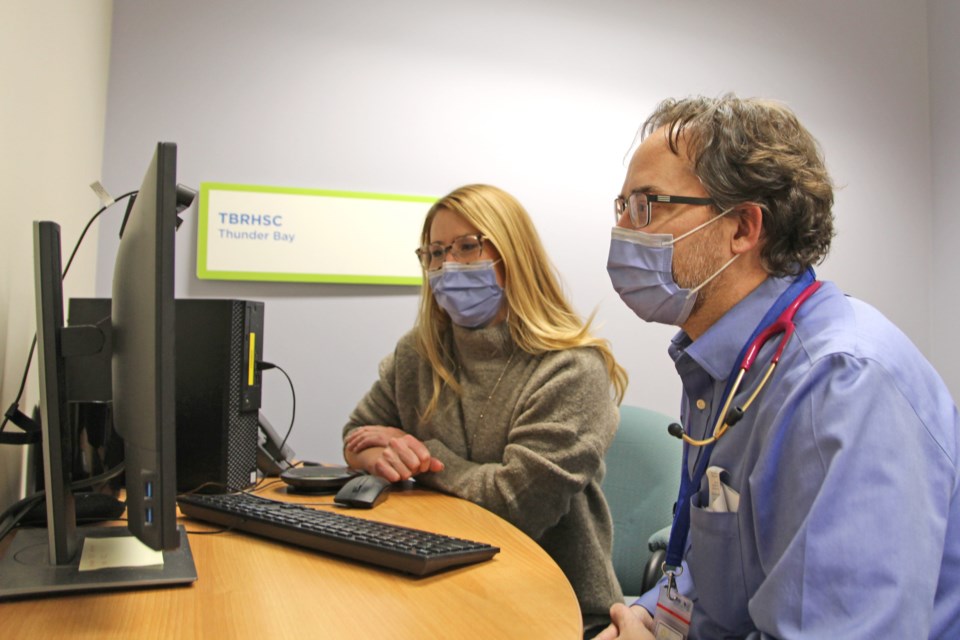The timing couldn’t be better.
That's the assessment from Dr. Teresa Bruni, one of the program leads for a virtual pediatric ER program for small and rural hospitals from Kenora to Marathon delivered by the Thunder Bay Regional Health Sciences Centre.
“We are being overwhelmed by very sick pediatric patients, so I think this is a great time to roll this out and help our community hospitals with these patients,” Bruni said.
The program allows a pediatrician in Thunder Bay to examine a child by video conference using provincial telemedicine tools.
The regional hospital said Bruni, a pediatrician and the medical director of the women and children's program along with Meghan Hill, a registered nurse and the regional paediatric lead, were instrumental in developing the program.
Bruni said they are so happy they were able to make this program happen.
She said for many years, the region has been asking, “when were we going to start virtual video support for the pediatric patients?” much like the well-received adult critical care response that has been available in the Northwest.
“With the support of our regional hospitals and our hospital here, we came up with an initiative to start to put together a regional pediatric critical response program,” Bruni said.
The pediatrics group in Thunder Bay currently has nine pediatricians.
“We certainly have increased our numbers over the years and again another reason why we feel we need to step up and provide this enhanced service. We have more resources now,” Bruni said.
Since the program started on Nov. 21, the Regional Paediatric Response program has already made five consultations, as of Tuesday.
“The first one I did with Meghan was a little boy with asthma, but he was really upset with all the interventions and he was screaming quite a bit, which is a good sign because you have to have lots of energy and be well enough to scream,” Bruni said. “I think it’s the parents [who] felt really reassured just having that support and collaboration between the doctors and the teams.”
Hill added, “I had a little younger guy who I think was just thrilled to see someone on the TV talking to him.”
The consultations have allowed two pediatric patients to be maintained in their communities without needing to be transferred to Thunder Bay, Hill said
Bruni said they were fortunate to designate Hill as the lead for the pilot project, “because Meghan was instrumental and very involved in the adult program, so she’s been involved for many years and she’s been an adult ICU nurse.”
Hill said the Regional Paediatric Response program was basically modelled after the Regional Critical Care Response program.
“It’s also been able to give us a second set of eyes on our patients in the region where they lack the resources that we have here at our bigger centre,” she said.
“The biggest thing is starting those early interventions and potentially having decreased hospital stays once they get here because those interventions have been started at an appropriate time. The overall goal is to provide high quality care to the right patient in the right place at the right time.”
Hill said one area of support the regional partners have asked for with this program is pediatric education.
The benefits of the program are more than just initiating early intervention for pediatric patients, she said.
"It’s actually just providing that support to those [healthcare] positions in the smaller hospitals, where they might not see these children very often," Hill said. "We’re able to extend that support using virtual [technology] and kind of decreasing geographical barriers that we have in the Northwest.”
Hill said the pediatricians receive an average of up to 300 calls for consults from regional sites per year, and being able to see the patients is an added enhancement to just dealing with it over the phone.
Bruni said a reality of the North is that it can take a long time to get an air transport to Thunder Bay or to travel by road. She said the service can help provide support during the wait for transport, which can further help stabilize the patient so they come in better shape. As well, the Regional hospital would have a better idea of what shape the child is in when they arrive, so staff can be better prepared.
As the pediatric centre for the region, Bruni said, the Thunder Bay regional hospital has always provided 24/7 phone support.
“Now we are able to add the video component,” she said. “I have great respect and admiration for our regional physicians and allied health, when they have a sick child, even in our hospital it can be so stressful and overwhelming so having that support even sometimes you’re doing a great job just reassuring them, helping support them.”
Bruni said this is the pilot year for the program, although she is feels it will be a permanent program and in fact hopes it expands beyond the 12 small and rural hospitals, to cover nursing stations as well.
She said the program is staffed with pediatricians Monday through Friday 8 a.m. to 4 p.m. with other staff from critical care during evenings and weekends. Her hope is that it expands to a 24-hour operation.
“I think COVID showed us technology does have a place in healthcare and in delivering enhanced healthcare as a supplement to what we’re doing,” she said. “So I’m hoping we’ll be able to make a business case to expand this service.”
